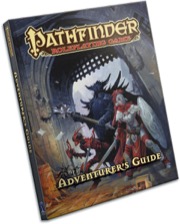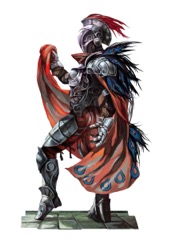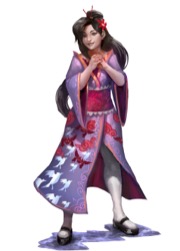Adventurer's Guide: Behind the Scenes
Thursday, May 11, 2017
We've been pretty vocal (I hope!) about one of the big changes to the rulebook line with the introduction of significant amounts of world content from Golarion in the upcoming Adventurer's Guide. In fact, we've been relaxing the "world-neutral" element of the rulebook line for some time, as far back as Occult Adventures where we abandoned the generic names for planes like the Boneyard and just used the Golarion/Great Beyond names in there. By lifting this self-imposed restriction, we're not fundamentally changing the type of content we're putting in rulebooks, but it does allow us to make our own rulebooks work even better with our own campaign setting.
Golarion is, after all, the setting used most overall by Pathfinder players. Gamemasters who run Pathfinder games set in other settings already had to decide how to incorporate flavor into their campaigns, changing names as needed, so whether or not they're changing the name of something called a "Red Mantis" or "Crimson Killer" or a "Scarlet Slayer" or whatever, by using the Golarion name we're making it more elegant and obvious how it fits into the vast majority of everything else Paizo publishes. But in order to standardize things for those who wish to reference names that remain our product identity, the Rules index for Adventurer's Guide lists alternate names as appropriate. So, if you want to use the Aldori swordlords in your game, you can either make a name up that fits your setting, use the "Aldori swordlord" in your setting, or go with our suggested "world neutral" name. So for example, the "Aldori defender" archetype becomes the "sword duelist defender", the "Aldori dueling sword" is merely the "dueling sword", and so on.
But there's another element in Adventurer's Guide that does something a little different, and this should specifically appeal to and intrigue fans of Golarion. When we were deciding what organizations to include in this book, there were a few that were no-brainers—Hellknights, Red Mantis, and the Pathfinder Society to name a few. We also knew we wanted to explore some of the concepts we've come up with more recently, like the Rivethun. But there was another category that was a bit trickier—organizations that we debuted and explored in our Adventure Paths. In many ways, these groups have become some of the most well-known organizations, because they've been the focus of entire campaigns. I'm talking about groups like the Council of Thieves, the Silver Ravens, the Cyphermages, and the Lantern Bearers—groups that were created for an Adventure Path first.
Perhaps the most famous of all these groups are the Gray Maidens—and in this case, they were absolutely created for an Adventure Path. Until the events of Curse of the Crimson Throne occur, there are no Gray Maidens at all in Golarion. But of all the groups in the setting, the look of the Gray Maiden has hit more eyes than ANY other group… because we put the iconic image of a Gray Maiden (created by the ever-talented Eva Widermann) on the back of the Core Rulebook itself.
So how can we present information about an organization that might well not even exist yet?
The answer was to make the assumption that the content of the Adventurer's Guide exists in a world after the events of those campaigns have played out. This allowed us to not only include groups like this in the book, but to explore how the events of their campaigns changed and shaped them. In the case of the Lantern Bearers in particular, this change is incredibly significant. In the Second Darkness Adventure Path, the Lantern Bearers were a puppet group manipulated by a shadowy conspiracy. In Adventurer's Guide, the assumption is that the Lantern Bearers have come out from that shadow and are well on the way to recovering and redeeming themselves. They still seek to stem the evil of demon worship and threats from the Darklands, but do so in a way more aimed at redeeming lost sisters and brothers and saving them from themselves rather than via shadowy stealth ops or conspiracy tactics. This results in a far more interesting group with less cliche and more growth to build upon.
We've made every attempt to avoid spoiling adventure paths from which these groups came from, of course, with the goal of having this content serve almost like a movie trailer; you won't learn everything there is to know about the plot of the Council of Thieves Adventure Path by reading the Council of Thieves chapter in Adventurer's Guide, but if we've done our job right, you'll be intrigued and perhaps want to play or run Council of Thieves as a result. The bulk of the new rules options for these groups are all brand new, so if you're a GM you can use the prestige classes and archetypes and items and spells and options in Adventurer's Guide to enhance an Adventure Path as you run it, perhaps even by giving out options to PCs as rewards for progressing through the story. You can also use them to bolster elements in an ongoing campaign, of course.
And that's it for this week! We've got a few more Adventurer's Guide previews coming in the weeks to come, so if there's an element of the book that folks are particularly eager in seeing a preview of, let me know in the comments below. In closing, I think I'm gonna show off the illustrations we've got in the book for three of the prestige classes inspired by groups that had their genesis in an Adventure Path—the Westcrown Devil, the Sanguine Angel, and the Argent Dramaturge!
James Jacobs
Creative Director
We have updated our Privacy Policy.
Paizo.com uses cookies. You can block paizo.com from using cookies within your browser settings, but doing so will hinder site functionality.
More information can be found in our Privacy Policy.



